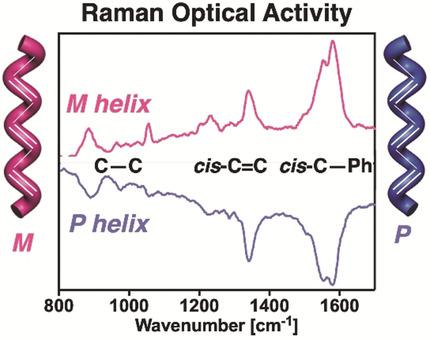当前位置:
X-MOL 学术
›
Angew. Chem. Int. Ed.
›
论文详情
Our official English website, www.x-mol.net, welcomes your
feedback! (Note: you will need to create a separate account there.)
Raman Optical Activity (ROA) as a New Tool to Elucidate the Helical Structure of Poly(phenylacetylene)s.
Angewandte Chemie International Edition ( IF 16.1 ) Pub Date : 2020-03-03 , DOI: 10.1002/anie.202000651 Luis Palomo 1 , Rafael Rodríguez 2 , Samara Medina 1 , Emilio Quiñoá 2 , Juan Casado 1 , Félix Freire 2 , Francisco J Ramírez 1
Angewandte Chemie International Edition ( IF 16.1 ) Pub Date : 2020-03-03 , DOI: 10.1002/anie.202000651 Luis Palomo 1 , Rafael Rodríguez 2 , Samara Medina 1 , Emilio Quiñoá 2 , Juan Casado 1 , Félix Freire 2 , Francisco J Ramírez 1
Affiliation

|
Poly(phenylacetylene)s are a family of helical polymers constituted by conjugated double bonds. Raman spectra of these polymers show a structural fingerprint of the polyene backbone which, in combination with its helical orientation, makes them good candidates to be studied by Raman optical activity (ROA). Four different well-known poly(phenylacetylene)s adopting different scaffolds and ten different helical senses have been prepared. Raman and ROA spectra were recorded and allowed to establish ROA-spectrum/helical-sense relationships: a left/right-handed orientation of the polyene backbone (Mhelix /Phelix ) produces a triplet of positive/negative ROA bands. Raman and ROA spectra of each polymer exhibited the same profile, and the sign of the ROA spectrum was opposite to the lowest-energy electronic circular dichroism (ECD) band, indicating a resonance effect. Resonance ROA appears then as an indicator of the helical sense of poly(phenylacetylene)s, especially for those with an extra Cotton band in the ECD spectrum, where a wrong helical sense is assigned based on ECD, while ROA alerts of this misassignment.
中文翻译:

拉曼光学活性(ROA)作为阐明聚苯乙炔螺旋结构的新工具。
聚(苯基乙炔)是由共轭双键构成的一类螺旋聚合物。这些聚合物的拉曼光谱显示多烯主链的结构指纹,结合其螺旋取向,使其成为通过拉曼光学活性(ROA)研究的良好候选物。已经制备了采用不同支架和十种不同螺旋感的四种不同的众所周知的聚苯乙炔。记录拉曼光谱和ROA光谱,并允许它们建立ROA光谱/螺旋感官关系:多烯骨架的左/右手方向(Mhelix / Phelix)产生正/负ROA带的三重态。每种聚合物的拉曼光谱和ROA光谱显示出相同的轮廓,并且ROA光谱的符号与最低能量的电子圆二色性(ECD)谱带相反,表示共振效应。然后,共振ROA似乎是聚(苯基乙炔)螺旋感的指标,尤其是对于那些在ECD光谱中具有额外棉带的人,其中基于ECD分配了错误的螺旋感,而ROA会提示这种错误分配。
更新日期:2020-03-03
中文翻译:

拉曼光学活性(ROA)作为阐明聚苯乙炔螺旋结构的新工具。
聚(苯基乙炔)是由共轭双键构成的一类螺旋聚合物。这些聚合物的拉曼光谱显示多烯主链的结构指纹,结合其螺旋取向,使其成为通过拉曼光学活性(ROA)研究的良好候选物。已经制备了采用不同支架和十种不同螺旋感的四种不同的众所周知的聚苯乙炔。记录拉曼光谱和ROA光谱,并允许它们建立ROA光谱/螺旋感官关系:多烯骨架的左/右手方向(Mhelix / Phelix)产生正/负ROA带的三重态。每种聚合物的拉曼光谱和ROA光谱显示出相同的轮廓,并且ROA光谱的符号与最低能量的电子圆二色性(ECD)谱带相反,表示共振效应。然后,共振ROA似乎是聚(苯基乙炔)螺旋感的指标,尤其是对于那些在ECD光谱中具有额外棉带的人,其中基于ECD分配了错误的螺旋感,而ROA会提示这种错误分配。











































 京公网安备 11010802027423号
京公网安备 11010802027423号